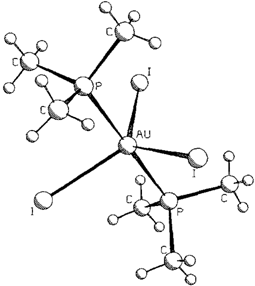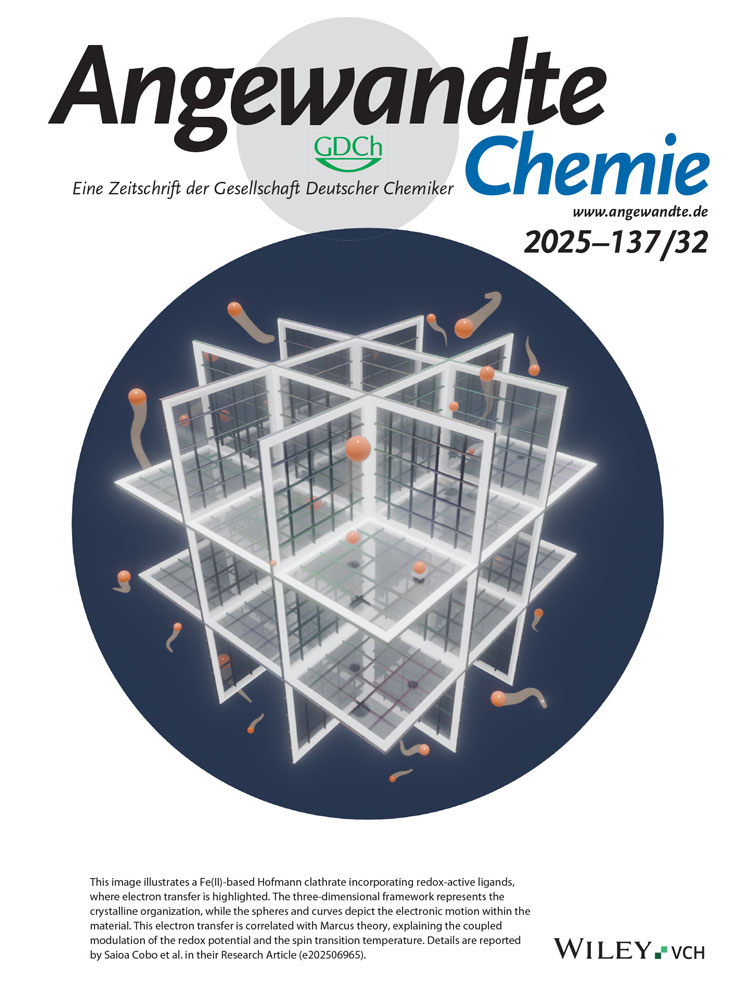Die Oxidation von Goldpulver durch Me3EI2 (E = P, As) unter einfachen Bedingungen: Synthesen und Strukturen von [AuI3(PMe3)2], [AuI3(AsMe3)] und [(Me3PO)2H][AuI2]†
Corresponding Author
Dr. Stephen M. Godfrey
Department of Chemistry University of Manchester Institute of Science and Technology Manchester M60 1QD (Großbritannien) Telefax: Int. +161/228–1250
Department of Chemistry University of Manchester Institute of Science and Technology Manchester M60 1QD (Großbritannien) Telefax: Int. +161/228–1250Search for more papers by this authorNicholas Ho
Department of Chemistry University of Manchester Institute of Science and Technology Manchester M60 1QD (Großbritannien) Telefax: Int. +161/228–1250
Search for more papers by this authorProf. Dr. Charles A. McAuliffe
Department of Chemistry University of Manchester Institute of Science and Technology Manchester M60 1QD (Großbritannien) Telefax: Int. +161/228–1250
Search for more papers by this authorDr. Robin G. Pritchard
Department of Chemistry University of Manchester Institute of Science and Technology Manchester M60 1QD (Großbritannien) Telefax: Int. +161/228–1250
Search for more papers by this authorCorresponding Author
Dr. Stephen M. Godfrey
Department of Chemistry University of Manchester Institute of Science and Technology Manchester M60 1QD (Großbritannien) Telefax: Int. +161/228–1250
Department of Chemistry University of Manchester Institute of Science and Technology Manchester M60 1QD (Großbritannien) Telefax: Int. +161/228–1250Search for more papers by this authorNicholas Ho
Department of Chemistry University of Manchester Institute of Science and Technology Manchester M60 1QD (Großbritannien) Telefax: Int. +161/228–1250
Search for more papers by this authorProf. Dr. Charles A. McAuliffe
Department of Chemistry University of Manchester Institute of Science and Technology Manchester M60 1QD (Großbritannien) Telefax: Int. +161/228–1250
Search for more papers by this authorDr. Robin G. Pritchard
Department of Chemistry University of Manchester Institute of Science and Technology Manchester M60 1QD (Großbritannien) Telefax: Int. +161/228–1250
Search for more papers by this authorDiese Arbeit wurde vom Engineering and Physical Sciences Research Council und von Johnson Matthey Plc. unterstützt.
Abstract
Überraschenderweise reagiert nicht-aktiviertes Goldpulver mit Me3EI2 (E = P, As) in Diethylether zu trigonal-bipyramidalem [AuI3(PMe3)2] (siehe Bild), das zu [(Me3PO)2H]-[AuI2] hydrolysiert wird, und zu planarem [AuI3(AsMe3)]. Die Oxidation zu Au3+ und die Herstellung von Komplexen mit unterschiedlicher Stöchiometrie und Struktur illustrieren sowohl die Oxidationskraft als auch die Finesse dieser Me3EI2-Verbindungen.
References
- 1 F. A. Cotton, G. Wilkinson, Comprehensive Inorganic Chemistry, 5. Aufl., Wiley, New York, 1988.
- 2 S. M. Godfrey, D. G. Kelly, A. G. Mackie, C. A. McAuliffe, R. G. Pritchard, S. M. Watson, J. Chem. Soc. Chem. Commun. 1991, 1447.
- 3
S. M. Godfrey,
A. G. Mackie,
C. A. McAuliffe,
R. G. Pritchard,
Angew. Chem.
1992,
104,
932;
10.1002/ange.19921040742 Google ScholarAngew. Chem. Int. Ed. Engl. 1992, 32, 919.
- 4 N. Brickleband, S. M. Godfrey, C. A. McAuliffe, R. G. Pritchard, J. Chem. Soc. Dalton Trans. 1995, 2421.
- 5 S. M. Godfrey, C. A. McAuliffe, R. G. Pritchard, J. Chem. Soc. Chem. Commun. 1994, 45.
- 6 S. M. Godfrey, H. P. Lane, C. A. McAuliffe, R. G. Pritchard, J. Chem. Soc. Chem. Commun. 1993, 1190.
- 7 P. L. Kuch, R. S. Tobias, J. Organomet. Chem. 1976, 122, 429.
- 8 A. Laguna, M. Laguna, J. Organomet. Chem. 1990, 394, 743.
- 9 A. D. Westland, Can. J. Chem. 1969, 47, 4135.
- 10 N. W. Alcock, P. Moore, P. A. Lampe, K. F. Mok, J. Chem. Soc. Dalton Trans. 1982, 207.
- 11 P. A. Bates, J. M. Water, Inorg. Chem. Acta 1985, 98, 125.
- 12 D. B. Dyson, R. V. Parish, C. A. McAuliffe, R. G. Pritchard, R. Fields, B. Beagley, J. Chem. Soc. Dalton Trans. 1989, 907.
- 13 G. A. Bowmaker, J. C. Dyason, P. C. Healy, L. M. Englehardt, C. Pakawatchai, A. H. White, J. Chem. Soc. Dalton Trans. 1987, 1089.
- 14 M. F. Perutz, O. Weisz, J. Chem. Soc. 1946, 438.
- 15 W. R. Mason, H. B. Grey, Inorg. Chem. 1968, 7, 55.
- 16 G. Bandoli, D. A. Clemente, G. Marangoni, L. Cattalini, J. Chem. Soc. Dalton Trans. 1973, 886.
- 17 H. Brown, G. C. McKinlay, W. E. Smith, Inorg. Chim. Acta 1979, 32, 117.
- 18 R. Uson, A. Laguna, H. Laguna, E. Fernandez, M. D. Villacampa, P. G. Jones, G. M. Sheldrick, J. Chem. Soc. Dalton Trans. 1983, 1669.
- 19 D. S. Eggleston, D. F. Chodosh, D. T. Hill, D. R. Girard, Acta Crystallogr. Sect. C. 1984, 40, 1357.
- 20 R. J. Staples, T. Grant, J. P. Fackler, Acta Crystallogr. Sect. C. 1994, 50, 39.
- 21 C. M. Harris, R. S. Nyholm, J. Chem. Soc. 1957, 63.
- 22 C. M. Harris, T. N. Lockyer, J. Chem. Soc. 1959, 3083.
- 23 L. F. Warren, M. A. Bennett, Inorg. Chem. 1976, 15, 3126.
- 24 W. T. Robinson, E. Sinn, J. Chem. Soc. Dalton Trans. 1975, 726.
- 25 J. Vicente, M. C. Chicote, M. D. Bermudez, P. G. Jones, C. Fittschen, G. M. Sheldrick, J. Chem. Soc. Dalton Trans. 1986, 2361.
- 26 Strukturanalyse von [AuI3(AsMe3)]: monoklin 21/m (Nr. 11), a = 10.089(4), b = 7.576(3), c = 15.016(6) Å, β = 90.65(3)°, V = 1148(1) Å3, Z = 4, R = 0.068 Rw = 0.050 für 76 Parameter und 759 beobachtete Reflexe (I > 3.00σ(I)) erhalten bei 296 K, MoKα, ä = 235.64 cm−1, 2θmax. = 47.1°, F(000) = 1192, Siemens-R3VS-Diffraktometer, Absorptionskorrektur (max./min. Transmission 1.19/0.82). Die Struktur wurde mit Direkten Methoden bestimmt, alle Nicht-Wasserstoffatome wurden unter Verwendung anisotroper Temperaturfaktoren verfeinert. Die Wasserstoffatome wurden zu vorausberechneten Positionen unter Verwendung festgesetzter isotroper Temperaturfaktoren fixiert.
- 27 Strukturanalyse von [AuI3(PMe3)2]: orthorhombisch, Pnma (Nr. 62), a = 10.488(4), b = 11.122(b), c = 14.279(3) Å, V = 1666(2) Å3, Z = 4, R = 0.047, Rw = 0.052 für 65 Parameter und 817 beobachtete Reflexe (I > 3.00 σ(I)) erhalten bei 296 K, MoKα, ä = 144.68 cm−1, 2θmax. = 49.9°, F(000) = 1288, Rigaku-R6S-Diffraktometer, Absorptionskorrektur (max./min. Transmission 1.00–0.13). Die Struktur wurde mit Direkten Methoden bestimmt, alle Nicht-Wasserstoffatome wurden unter Verwendung anisotroper Temperaturfaktoren verfeinert. Die Wasserstoffatome wurden an vorausberechneten Positionen unter Verwendung festgesetzter isotroper Temperaturfaktoren fixiert.
- 28 Strukturanalyse von [(Me3PO)2H][AuI2]: monoklin, I2/m (No. 12), a = 16.623(3), b = 8.173(3), c = 6.228(2) Å, β = 89.81(3)°, V = 846.0(7) Å3, Z = 2, R = 0.037, Rw = 0.043 für 38 Parameter und 412 beobachtete Reflexe (I > 3.00 σ(I)) erhalten bei 296 K, MoKα, ä = 124.48 cm−1, 2θmax. = 45.0°, F(000) = 572, Rigaku-R6S-Diffraktometer, Absorptionskorrektur (max./min. Transmission 0.75/-0.66). Die Struktur wurde mit Direkten Methoden bestimmt, alle Nicht-Wasserstoffatome wurden unter Verwendung anisotroper Temperaturfaktoren verfeinert. Die Wasserstoffatome wurden an vorausberechneten Positionen unter Verwendung freigesetzter isotroper Temperaturfaktoren fixiert. Die kristallographischen Daten (ohne Strukturfaktoren) der in dieser Veröffentlichung beschriebenen Strukturen wurden als „supplementary publication no. CCDC-179-108”︁ beim Cambridge Crystallographic Data Centre hinterlegt. Kopien der Daten können kostenlos bei folgender Adresse angefordert werden: The Director, CCDC, 12 Union Road, GB-Cambridge CB2 1EZ (Telefax: Int. +1223/3 360 33; E-mail: [email protected])
- 29 N. Bricklebank, S. M. Godfrey, H. P. Lane, C. A. McAuliffe, R. G. Pritchard, J. M. Moreno, J. Chem. Soc. Dalton Trans. 1995, 3873.
Citing Literature
This is the
German version
of Angewandte Chemie.
Note for articles published since 1962:
Do not cite this version alone.
Take me to the International Edition version with citable page numbers, DOI, and citation export.
We apologize for the inconvenience.





